
Citrus is a genus of flowering trees and shrubs in the rue family, Rutaceae. Plants in the genus produce citrus fruits, including important crops such as oranges, lemons, grapefruits, pomelos, and limes.

Marmalade is a fruit preserve made from the juice and peel of citrus fruits boiled with sugar and water. The well-known version is made from bitter orange, but it is also made from lemons, limes, grapefruits, mandarins, sweet oranges, bergamots, and other citrus fruits, or a combination.
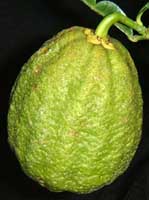
Citrus cavaleriei or Citrus ichangensis, the Ichang papeda, is a slow-growing species of papeda that has characteristic lemon-scented foliage and flowers.

Neohesperidin dihydrochalcone, sometimes abbreviated to neohesperidin DC or simply NHDC, is an artificial sweetener derived from citrus.
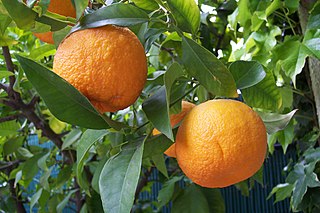
Bitter orange, Seville orange, sour orange, bigarade orange, or marmalade orange is the citrus tree Citrus × aurantium and its fruit. It is native to southeast Asia and has been spread by humans to many parts of the world. It is probably a cross between the Pomelo, Citrus maxima, and the Mandarin orange, Citrus reticulata.

The Jaffa orange is an orange variety with few seeds and a tough skin that makes it particularly suitable for export.
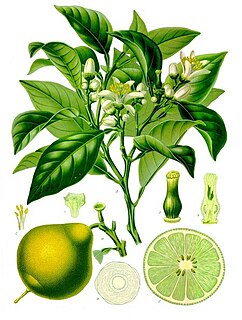
Citrus bergamia, the bergamot orange, is a fragrant citrus fruit the size of an orange, with a yellow or green color similar to a lime, depending on ripeness.
Laraha, or Curaçao orange, is the name of a citrus tree that grows on the island of Curaçao, and also the fruit of this tree. A descendant of the bitter orange, the fruit of the laraha is too bitter and too fibrous to be considered edible.

Naringenin is a flavorless, colorless flavanone, a type of flavonoid. It is the predominant flavanone in grapefruit, and is found in a variety of fruits and herbs.

Naringin is a flavanone-7-O-glycoside between the flavanone naringenin and the disaccharide neohesperidose. The flavonoid naringin occurs naturally in citrus fruits, especially in grapefruit, where naringin is responsible for the fruit's bitter taste. In commercial grapefruit juice production, the enzyme naringinase can be used to remove the bitterness created by naringin. In humans naringin is metabolized to the aglycone naringenin by naringinase present in the gut.
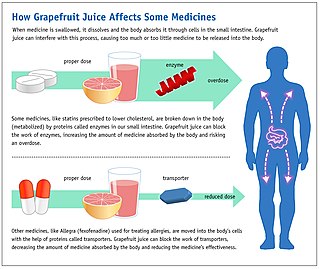
Some fruit juices and fruits can interact with numerous drugs, in many cases causing adverse effects. The effect was first discovered accidentally, when a test of drug interactions with alcohol used grapefruit juice to hide the taste of the ethanol.
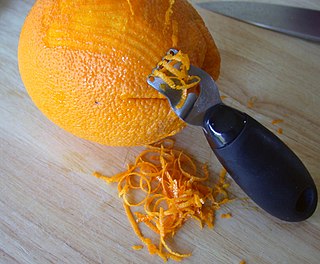
Zest is a food ingredient that is prepared by scraping or cutting from the rind of unwaxed citrus fruits such as lemon, orange, citron, and lime. Zest is used to add flavor to foods.

The orange is the fruit of various citrus species in the family Rutaceae ; it primarily refers to Citrus × sinensis, which is also called sweet orange, to distinguish it from the related Citrus × aurantium, referred to as bitter orange. The sweet orange reproduces asexually ; varieties of sweet orange arise through mutations.
Naringinase is a debittering enzyme that is used in the commercial production of citrus juices. It breaks down the compound naringin that gives citrus juices its bitter taste. It is a multienzyme complex which possesses alpha-L-rhamnosidase and beta glucosidase active centers. The E.C. No.(EC 3.2.1.40) of the naringinase and rhamnosidase are the same. First rhamnosidase breaks naringin into prunin and rhamnose. Lastly glucosidase breaks prunin into glucose and naringenin, a flavorless flavanone also found in various citrus.

Phloretin is a dihydrochalcone, a type of natural phenol. It can be found in apple tree leaves and the Manchurian apricot.

Dihydrochalcone (DHC) is a chemical compound related to chalcone.
Chōzaburō Tanaka or often Romanized as Tyôzaburô Tanaka was a Japanese botanist and mycologist. He established one of the two major taxonomic classification systems for citrus and related genera currently in use, and is now considered to be a taxonomic "splitter". He is the author of 180 botanical names in the citrus family Rutaceae, including for example Citrus × latifolia and Citrus tangerina (tangerine). Many of the species Tanaka described are still recognized, but his overall scheme is not supported by modern genetic research.

Narirutin is a flavanone-7-O-glycoside, consisting of the flavanone naringenin bonded with the disaccharide rutinose.
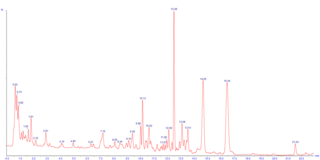
Neohesperidin is a flavanone glycoside found in citrus fruits. It is the 7-O-neohesperidose derivative of hesperetin, which in turn is the 4'-methoxy derivative of eriodictyol. Neohesperidin dihydrochalcone has an intense sweet taste, and is listed as a Generally Recognized as Safe flavour enhancer by the Flavour and Extract Manufacturers' Association.
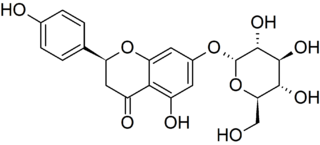
Prunin is a flavanone glycoside found in immature citrus fruits and in tomatoes. Its aglycone form is called naringenin.

















